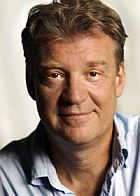


Jørgen Leth: Traberg

Jeg holder med, når jeg ser film. En af dem. Sådan har det altid været. Og nu holder jeg med Traberg. Ikke med stemmen. Erik Mørks, som fortæller om sin ven på fotografiet i det første filmbillede. Jeg holder med ‘Traberg som Traberg’ som der står på forteksten. Næste billede: en ung sort mand synger for. Nærbillede. Afrikansk musik, vi er i Haiti, uden tvivl. Og så er vi i Spanien, i en sportshal, hvor mænd på gulvet spiller op ad væggen. Mænd på stolerækker spiller. Om penge. Stemmen fortæller mig nødtørftigt om Traberg, som jeg nu ser der på stolen i hallen. Nær, energisk, til stede. Han er en mand, som bevæger sig fra sted til sted, fortæller stemmen, og den vil følge hans spor, for han må være forsvundet.
Sporet går til en lille spansk by, kameraet over de vidunderlige tegltage. Lyden er en skrivemaskine. Så ser jeg værelset, han er der ikke, men hans ting er der: skrivemaskinen, bøger og avisudklip. Stof om Haiti, et land i indbyrdes krig. Jeg ser tagene ud af vinduet. Det bliver sort, Trabergs hænder trækker skodderne for. I sin støvede 2 CV er han atter på rejse ad en ensom landevej i det vældige landskab. Alle elementer i filmen er på plads, nu følger jeg Traberg. Ham holder jeg med. Det er elementært.
Det er en stor film. Den samler flere af Filmens traditioner. Det er en surrealistisk film. Man kommer til at tænke på Buñuels ‘l’Age d’Or’ fra 1930, som handler om Roms grundlæggelse, statsmagten, banditter, borgerskab og et seksuelt-sadistisk præsteskabs kristendom. Alt kan ske i denne film, fordi alt kan ske i virkeligheden. Der er så mange logikker, der insisterer på at være reelle. Der er mange logikker, der er faktiske, og som mennesket får gennemført. Det er sjældent, at en film giver plads til dem alle. L’Age d’Or gjorde. Traberg gør. (Mogens Rukov i Information 19.12.1992).
Danmark, 1992. Plakat: Per Kirkeby
DVD-boksen “Fiktioner”, hvor Traberg er med, skulle udkomme i overmorgen. Den er blevet forsinket nogle dage, siger min boghandel. Jeg glæder mig vildt til at se Traberg igen, og Udenrigskorrespondenten igen.








